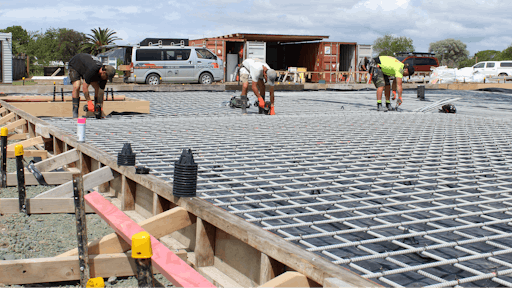Opening the Ecological Benefits of Recycled Composites in Construction and Style
In the world of construction and design, the usage of recycled composites holds considerable promise for improving sustainability techniques and lowering ecological impact. The change towards an extra lasting future in these sectors pivots on unlocking the complete capacity of recycled composites.

Ecological Influence Decrease
The decrease of environmental impact with making use of recycled composites in building and construction and style plays an essential function in lasting practices. By incorporating recycled composites right into building materials, the construction market can substantially decrease its carbon footprint and add to a much more environment-friendly future. These lasting materials, made from repurposed plastics, timber fibers, or other recycled elements, supply a viable choice to typical building and construction materials without endangering on quality or durability.
Recycled compounds help divert waste from landfills and reduce the need for drawing out resources, thus conserving natural sources. Additionally, the manufacturing process of these composites frequently takes in less power and produces fewer greenhouse gases compared to generating virgin materials (composites). This change towards using recycled compounds not just lessens ecological damage yet likewise advertises a circular economic climate by motivating the reuse of materials that would certainly or else be thrown out
Waste Minimization
With a concentrate on lessening waste in building and construction and design, the integration of recycled composites supplies a sustainable service to decrease ecological impact. Waste reduction is a vital facet of lasting techniques, and the use of recycled composites offers a chance to achieve this goal successfully. By utilizing materials that have already served their preliminary purpose, such as recycled plastics or redeemed timber fibers, the building and construction and layout sectors can significantly lower the amount of waste generated and sent to landfills.
Recycled compounds have the possible to draw away substantial quantities of waste from traditional disposal approaches, adding to a more round economic climate where resources are used successfully. Additionally, the production procedure of recycled composites usually takes in less energy and creates fewer emissions compared to virgin materials, additionally lowering the ecological footprint of building and construction and layout jobs.
Executing waste minimization strategies through the consolidation of recycled compounds not just assists in preserving natural deposits but likewise advertises a much more lasting technique to structure and creating for a greener future.
Energy Preservation
Incorporating recycled composites not just minimizes waste in building and construction and layout but also plays a critical role in boosting power preservation methods within the sector. The use of recycled compounds in building and construction can considerably add to power preservation through various ways. The production of virgin materials generally requires significant energy inputs, whereas utilizing recycled compounds consumes less energy, consequently lowering general energy intake. Additionally, integrating recycled composites can contribute to much better insulation homes in structures, decreasing the requirement for extreme heating or cooling, and subsequently decreasing power use for environment control. The light-weight nature of several recycled composites can lead to lighter structures, calling for less energy for transportation and installment. By advertising the usage of recycled compounds in building and construction and design, the industry can make considerable strides towards accomplishing power efficiency and lowering its carbon impact, eventually contributing to a more lasting built setting.
Carbon Footprint Reduction
Enhancing sustainability practices with the utilization of recycled composites in building and layout dramatically reduces the carbon footprint of the sector. By integrating recycled products right into the production of composites, the need for virgin sources reduces, see this website leading to lower energy usage and greenhouse gas exhausts associated with traditional production procedures. This reduction in carbon impact is important in combating climate adjustment and advertising a much more eco-friendly approach to construction and layout.
Furthermore, making use of recycled composites also aids in diverting waste from garbage dumps, thus alleviating the ecological influence of disposal and promoting a round economic situation. The carbon impact decrease achieved with the fostering of recycled compounds lines up with the international push towards sustainable practices and the reduction of industrial discharges. It showcases a commitment to accountable resource administration and a shift in the direction of greener options in the construction and style sectors. Eventually, by focusing on the integration of recycled compounds, the sector can make considerable strides in reducing its carbon footprint and adding to an extra sustainable future.
Sustainable Future
The combination of recycled composites in building and construction and layout not just addresses prompt environmental problems however also lays a strong structure for a lasting future in the industry. By including recycled composites into building products and products, the building and construction and style sectors can substantially minimize their reliance on virgin resources, leading to a much more circular economic climate. This change towards sustainability is crucial for alleviating the ecological impact of traditional building techniques, which often lead to high levels of waste generation and source exhaustion.

Final Thought
To conclude, recycled composites use significant environmental advantages in construction and design by decreasing environmental influence, minimizing waste, preserving power, decreasing carbon footprint, and advertising a sustainable future. Welcoming the usage of recycled composites can add to a more environmentally-friendly strategy to structure and style, eventually resulting in a more sustainable and greener future for all.
The reduction of environmental impact via the use of recycled composites in building and layout plays an important duty in sustainable methods.With an emphasis on reducing waste in building and layout, the integration of recycled composites provides a lasting option to lower ecological impact. By advertising the use of recycled composites in construction and style, the industry can make considerable strides in the direction of attaining energy efficiency and lowering its carbon impact, ultimately contributing to a more sustainable developed atmosphere.
